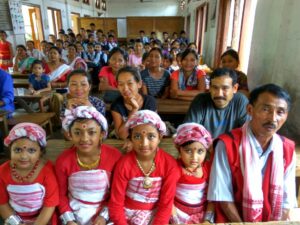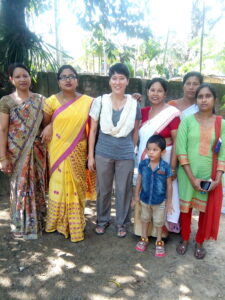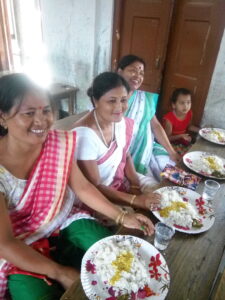Engaged Anthropology Grant: Dolly Kikon

While a doctoral student at Standford University Dolly Kikon received a Dissertation Fieldwork Grant in 2009 to aid research on “Blurred Borders: Unsettling the Hill/Valley Divide in Northeast India,” supervised by Dr. James G. Ferguson. In 2015 Dr. Kikon received an Engaged Anthropology Grant to aid engaged activities on “A Foothill Sanrhutav: Sharing Experiences of Women Traders in Northeast India”.
I successfully completed the foothill community gathering and feast on July 13. As I had submitted in the proposal, I was able to complete the key proposed goals: (a) present my research to the host communities; (b) provide a forum for the communities to gather and share their experiences and establish mentoring networks; (c) invite key actors of different indigenous communities such as village headmen, student associations, coal traders, teachers, border peace committees, and householders from Naga and Assamese villages to discuss the plight of women traders, and broadly gender relations among foothill communities. Due to the monsoon and unprecedented floods across Northeast India, several landslides had washed away roads and bridges. This prevented certain Naga villages situated in the uplands to attend the meeting. Given the existing challenges, I chose Gelekey, a small town in the foothill border of Assam and Nagaland as the venue of the community meeting and feast. The border town of Gelekey town (in Sibsagar district of Assam) shares its boundary with the districts of Longleng and Mokokchung (in Nagaland). Thus, Ahom, Assamese, Phom, and Ao villages attended the community gathering and shared their experiences and hardships of living in the militarized landscape.

The gathering was held at the Adarsha Bidyapith School in Gelekey town. The location of the meeting was both symbolic and strategic. Gelekey is not only an important coal-trading hub and oil exploration site, but also attracts numerous Naga villages from the uplands to the Atkhel haat, a weekly market that takes place in the outskirt of the town. Although the electricity was erratic, I was able to make a power point presentation and shared my experience about doing an ethnographic work among the host communities in the Assam-Nagaland border. Drawing from my field notes and the publications I have brought out (Anthropology News, Economic and Political Weekly, South Asia: Journal of South Asia), I explained my ethnographic journey at the gathering. During the community interaction session, communities underlined the anxieties of living in the foothills. They reiterated my ethnographic notes that I had connected between 2006-2011 about the place that witnessed a heightened presence of armed forces. This was due to the extractive resource activities like oil explorations, tea plantations, and coalmines across the foothill border of Assam and Nagaland. In addition, the foothills, like other parts of Northeast India, were under the jurisdiction on an extra-constitutional regulation known as the Disturbed Area Act and the Armed Forces Special Powers Act (1958). Movement of goods and people in the militarized foothills, as the community sharing revealed, immensely highlighted the importance of the Engaged Anthropology Grant that helped communities to come together and share their reflections and experiences. A central point of the community gathering and feast was to discuss the experiences of women traders from Nagaland in the foothill markets known as haats. Sharing my field notes and interviews of several women traders I had collected, I explained how these weekly markets represented the dynamic, multifaceted, and tangled lives of the residents of the villages in the foothills of Assam and Nagaland.

Women traders from Anaki C village shared their thoughts. Ms. Emer Phom, the president of the Phom women’s collective known as the Bedestha Group said that they had to go down to Assam for their basic needs like medicine, food, and clothing. Speaking at the research interaction, Mr. Shingnyu Phom, member of the Border Peace Committee from Yonglok village appealed to the gathering to maintain peace in the border areas and the importance of engaging in meaningful community dialogue. Adding to the conversations about peace, Mr. Imkong Phom, the village headman from Anaki C village thanked the gathering for the conversations and stressed the importance of understanding and respecting each others history. Mrs Kunti Borah Gogoi, an Ahom educationist from Gelekey reiterated the importance of maintaining the people to people dialogue and connection in the border area. She said that such communities gathering were important events to bring together the Naga people and the Ahom community to reaffirm their friendship and kinship as well. As a gesture of solidarity and love, she presented all the Naga guests with a phulon gamusa (a traditional Assamese scarf). Ms. Rashmi Saikia and Mr. Promud Monuranjan sang Nagamese, Assamese, and Hindi songs for the audience, and a group of mainas (little children) performed a Jhumur dance to conclude the meeting on a musical note. After the interaction, the guests were invited to a community feast.